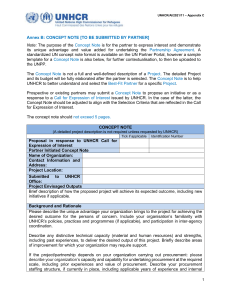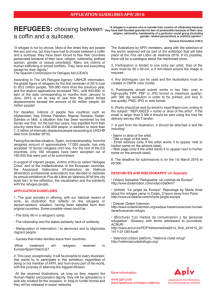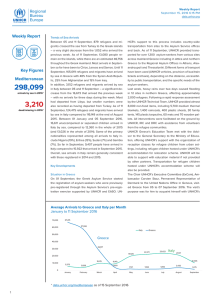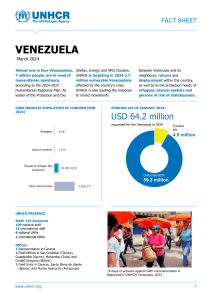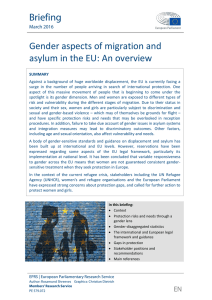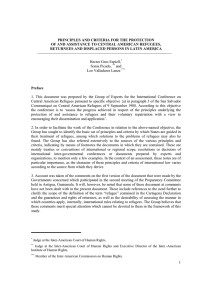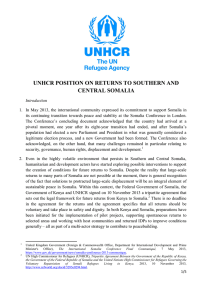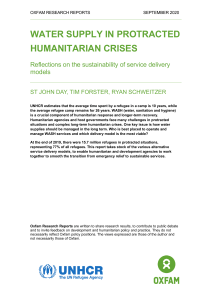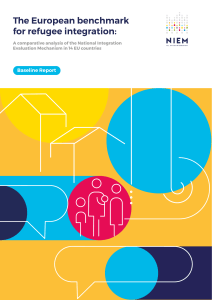64th Session of the Executive Committee of the High
Anuncio
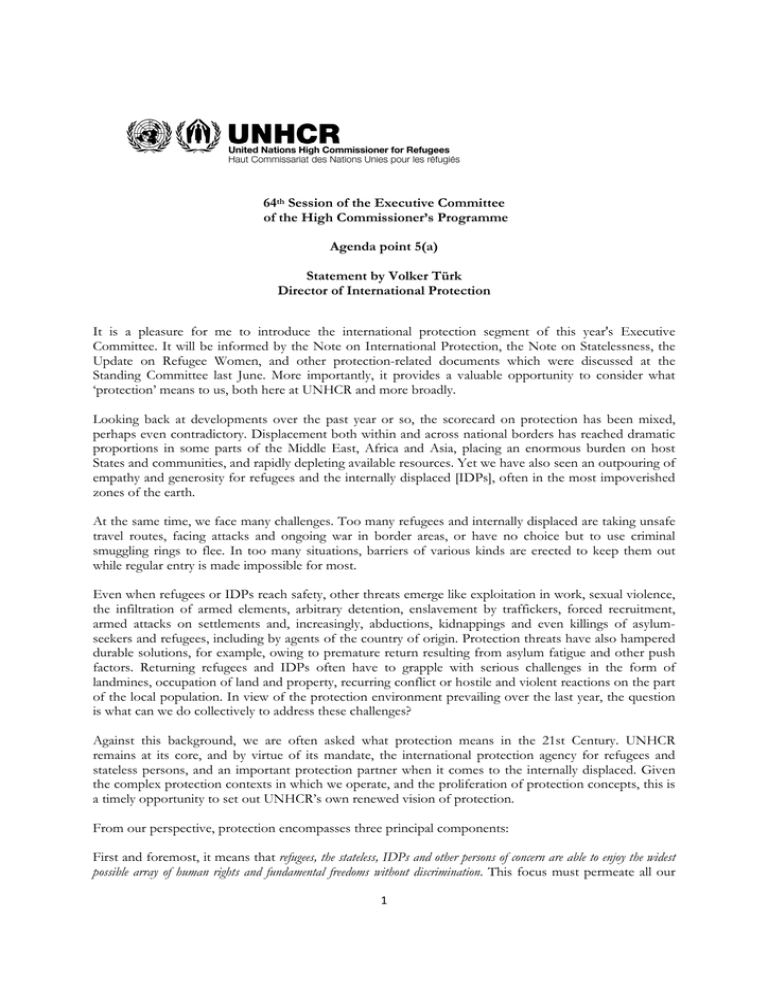
64th Session of the Executive Committee of the High Commissioner’s Programme Agenda point 5(a) Statement by Volker Türk Director of International Protection It is a pleasure for me to introduce the international protection segment of this year's Executive Committee. It will be informed by the Note on International Protection, the Note on Statelessness, the Update on Refugee Women, and other protection-related documents which were discussed at the Standing Committee last June. More importantly, it provides a valuable opportunity to consider what ‘protection’ means to us, both here at UNHCR and more broadly. Looking back at developments over the past year or so, the scorecard on protection has been mixed, perhaps even contradictory. Displacement both within and across national borders has reached dramatic proportions in some parts of the Middle East, Africa and Asia, placing an enormous burden on host States and communities, and rapidly depleting available resources. Yet we have also seen an outpouring of empathy and generosity for refugees and the internally displaced [IDPs], often in the most impoverished zones of the earth. At the same time, we face many challenges. Too many refugees and internally displaced are taking unsafe travel routes, facing attacks and ongoing war in border areas, or have no choice but to use criminal smuggling rings to flee. In too many situations, barriers of various kinds are erected to keep them out while regular entry is made impossible for most. Even when refugees or IDPs reach safety, other threats emerge like exploitation in work, sexual violence, the infiltration of armed elements, arbitrary detention, enslavement by traffickers, forced recruitment, armed attacks on settlements and, increasingly, abductions, kidnappings and even killings of asylumseekers and refugees, including by agents of the country of origin. Protection threats have also hampered durable solutions, for example, owing to premature return resulting from asylum fatigue and other push factors. Returning refugees and IDPs often have to grapple with serious challenges in the form of landmines, occupation of land and property, recurring conflict or hostile and violent reactions on the part of the local population. In view of the protection environment prevailing over the last year, the question is what can we do collectively to address these challenges? Against this background, we are often asked what protection means in the 21st Century. UNHCR remains at its core, and by virtue of its mandate, the international protection agency for refugees and stateless persons, and an important protection partner when it comes to the internally displaced. Given the complex protection contexts in which we operate, and the proliferation of protection concepts, this is a timely opportunity to set out UNHCR’s own renewed vision of protection. From our perspective, protection encompasses three principal components: First and foremost, it means that refugees, the stateless, IDPs and other persons of concern are able to enjoy the widest possible array of human rights and fundamental freedoms without discrimination. This focus must permeate all our 1 interactions with persons of concern. It must also provide the overall strategic direction to our operations and inspire the design, coordination and delivery of services. A rights-based approach to the delivery of services and assistance is inherent to UNHCR’s protection mandate. This also means that we keep solutions to the plight of those we serve in mind right from the beginning. Second, it means delivering concrete, quality protection services such as, for example, prompt access to professional care for victims of sexual violence, legal aid to ensure access to justice, registration and determination of asylum claims, individual documentation, reunification of children with their parents or care-givers, support to voluntary repatriation, resettlement, and advocacy for stateless persons. It also means advocating for and intervening on behalf of refugees and other persons of concern when they are at risk, for instance, when in detention or in danger of refoulement. UNHCR is committed to exercising its supervisory role in relation to relevant international treaties [a fundamentally legal function requiring UNHCR to intercede with Governments on behalf of refugees and stateless persons]. Strengthening proper implementation of the 1951 Convention unquestionably impacts positively on the protection of refugees. Third, it means integrating protection considerations into every service or assistance we deliver [mainstreaming protection]. Protection informs our shelter, Water, Sanitation and Hygiene [WASH], health or education programmes, as well as the delivery of humanitarian assistance. Whatever we do to assist refugees, we must understand and appreciate the protection dimensions of our actions. Building refugee camps too close to the border can, for example, multiply the risk of infiltration of soldiers and forced recruitment. Failing to properly think through the layout of camps can put women and girls at risk of rape, abduction and other serious rights violations. Failure to adequately plan for WASH can lead to community tensions and violence; not only amongst refugee populations, but also between refugee and host communities. With this understanding of protection in mind, I would like to elaborate on a number of our priority areas for the coming period and make concrete proposals under each of how we can, together, take such a protection agenda forward. Specifically, I’d like to focus, first, on the workings of the 1951 Convention and protection systems in today’s context; second, on promoting accountability, equality and empowerment in our operations; third, on searching for solutions; and fourth, on our goal of eliminating statelessness. Moreover, fifth, the upcoming High Commissioner’s Dialogue in December will give us a much needed opportunity to focus on the challenges of meeting the protection needs of IDPs, which is why I am not going to address this specifically now, in the interest of time. From tools to action Protection activities and approaches are anchored in international norms and standards and yet must be delivered with a deep awareness of circumstances and contexts in which we work. The time has perhaps come to reframe protection as a broader governance issue. I am saying this because we seem to have an almost cyclical debate about the core principles of the international refugee protection regime, at the heart of which is the 1951 Convention and its 1967 Protocol. Let us not forget that the 1951 Convention is a hallmark of civilization and our common heritage of humanity. It is the instrument that has saved millions of lives over its 62-year long existence. We know it will be needed in the future as long as serious human rights abuses, persecution and violent conflict exist. And let us also not forget that the Convention emerged from the strong ‘never again’ sentiment prompted by the horrific experience of the Second World War. Both instruments have adapted and endured through decades of significant changes, but their implementation continues to hinge upon tolerant, open and compassionate societies, with a devotion to the fundamental worth, inherent dignity and rights of each and every human being. At the same time, the Convention is not the be-all and the end-all. It has its rightful place but it was never meant to address broader migration challenges or law enforcement issues. It is clear that it has to be supplemented through human rights law, law relating to smuggling and trafficking as well as broader migration policy and, of course, proper governance structures. Over the years various methods and tools have been developed to ‘contextualize’ the Convention within a broader environment and to complement it. The purpose of the protection conclusions adopted by this 2 Committee was to do precisely that; as is true of the Agenda for Protection or tools developed by UNHCR, such as the 10-Point Plan of Action on Refugee Protection and Mixed Migration or the Model Framework of Cooperation on Rescue at Sea. A common theme running through all of these efforts has been the assumption of responsibilities, such as non-refoulement, admission, and reception, coupled with multilateral cooperation to share burdens and responsibilities. The one goes hand in hand with the other. The challenge of addressing mixed flows of people seeking protection together with those moving for other reasons is not an easy one to address. In this connection, Madam Chair, let me highlight in particular one priority area we are working on: the protection of refugees and asylum-seekers in search of safety by sea. Hardly a day goes by without reports about boat arrivals, dramatic rescue scenarios and people perishing at sea. Such movements by sea are a global phenomenon, occurring in most regions, as the continuous flow of Somalis, Ethiopians and Eritreans across the Gulf of Aden, increasing numbers of boat arrivals in South East Asia and Australia, as well as regular boat incidents in the Mediterranean and Caribbean amply demonstrate. The protection of refugees and asylum-seekers moving by sea [maritime protection], often within larger irregular movements, raises a number of complex legal and practical challenges. These include, for example, questions around jurisdiction and state responsibility; the need for a proper balancing between legitimate concerns about border security and refugee protection; and the need for proper mechanisms for international cooperation and predictable burden and responsibility sharing. Earlier this year, roundtables on this issue were held in Jakarta and the Bahamas, and the Yemeni Government intends to hold a regional conference in November. We hope that this and other planned events will contribute to the sharing of good practices, help develop practical arrangements to implement existing standards and facilitate rescue and disembarkation of asylum–seekers and refugees in distress at sea. Moreover, we hope to encourage a culture of burden sharing in this area. Developments in this area remind us of the importance of moving from tools to action. In short, let’s ensure that the 1951 Convention has its rightful place, while working further on practical arrangements in complex migratory contexts, notably in rescue at sea scenarios. This could be a practical contribution to follow-up work in connection with the General Assembly’s High-Level Dialogue on Migration and Development taking place this week. Applying the 1951 Convention to people fleeing conflict and other situations of violence Let me now turn to the Refugee Convention more specifically. One particular aspect where it is important to restore the Convention to its proper place is in relation to people fleeing armed conflict and other situations of violence. The causes, character and effects of these conflicts, as well as the emergence of a range of other situations of violence, have spawned new challenges in the protection arena. In many countries, a perpetual cycle of violence and conflict has become a daily reality. At present, more than 80% of persons of concern to UNHCR have fled armed conflicts and violence. But the very nature of armed conflict has changed, with civilians playing an increasingly important role, both as participants in armed conflicts and as victims of their impacts and consequences. Refugee flight and internal displacement are not mere consequences of conflict: they are, too often, the very objective of those waging war. There is a lack of common understanding about how these conflicts, and the international protection needs of those fleeing them, are in sync with existing protection frameworks at the national, regional and international levels. There are suggestions that the 1951 Convention definition is difficult to reconcile with the size, scale and character of many modern conflicts and refugee flows. As a result, a divergence in State practice has emerged in the way the international protection needs are recognized for those fleeing conflicts, as we can see today, for instance, in relation to Syrian refugees in Europe. We have seen a trend by some States to accord subsidiary protection to those fleeing conflict and armed violence, where circumstances would, perhaps, warrant full refugee recognition. Subsidiary protection is not a substitute 3 for refugee status and it is therefore important to uphold the 1951 Convention and State commitment to it by according full recognition under its terms where this is warranted. Over the last year, we have embarked on a project in order to improve our understanding in this area. The results confirmed the primacy of the 1951 Convention. Whilst violence may often seem to be indiscriminate at first glance, a more in-depth analysis reveals that individuals or groups are fleeing harm on account of racial, ethnic, religious, political, gender or social grounds. War and violence may themselves be used as instruments of persecution and, even in situations of generalized violence, people may be forced to flee on account of a well-founded fear of persecution for Convention reasons. The research also looked at the particular issue of gender violence within armed conflict, and the many obstacles that women and girls face in having such claims accepted under the Convention. Later this year we will issue Guidelines on the application of the 1951 Convention to people fleeing armed conflict and other situations of violence, to assist States and decision-makers involved in refugee status determination procedures. In short, let’s encourage a contemporary understanding of the 1951 Convention, and ensure that status is appropriately granted to people fleeing armed conflict and violence. Promoting more Government ownership and capacity in asylum/protection systems Over the next couple of years, national asylum/protection systems will be an important theme for UNHCR. We want to take a fresh look at the ‘basics’ of what such systems should entail, and focus on ensuring quality adjudication processes that can fairly and efficiently determine who is, and who is not, in need of international protection. The overarching theme of the Note on International Protection is ‘protection systems’. In many contexts, determining who is a refugee is the first step towards accessing protection and thus must be an essential element in national asylum systems. I would also like to take this opportunity to sound a word of caution here against a trend in some countries to make the asylum system overly cumbersome, complex and elaborate, and hence less effective. As the Note explains, UNHCR assists Governments to establish sustainable national asylum systems, which provide for access to territory and protection from refoulement; humane and dignified reception arrangements [including protection against arbitrary detention]; fair and efficient status determination procedures; the enjoyment of rights; and access to durable solutions. Throughout the past year, many governments have engaged in migration or asylum reform processes. We have welcomed the opportunity to comment upon many draft laws and policies, and to provide technical advice, including in respect of new or forthcoming laws in Afghanistan, Angola, Botswana, the Republic of Congo, Rwanda and Turkey; many of which focus on the RSD process. We are encouraged by actions taken by Cameroon, Hong Kong and Morocco to assume responsibility for RSD, particularly the recent move by Morocco towards a new immigration policy. We also congratulate the European Union for the completion of the recast processes. It is also important to acknowledge the many Governments who carry out refugee status determination with due diligence and efficiency. In 2013, significant progress was made in improving the quality and efficiency of individual RSD procedures in regions where governments are responsible for RSD. Following several such initiatives in Europe, three Governments in Latin America [Mexico, Costa Rica and Panama] worked together with UNHCR on a regional Quality Assurance Initiative. For our part, UNHCR continues to conduct RSD in more than 60 countries or territories and to register an increasing number of individuals seeking international protection. In 2012, UNHCR was solely responsible for RSD decision-making in almost 50 of 170 countries that shared asylum statistics with UNHCR. In another 23 countries or territories, UNHCR conducted RSD in parallel to, or jointly with Governments. In many other countries or territories, UNHCR provides technical or other support to Governments. In 2012, UNHCR registered 110,400 new individual asylum applications in its procedures [12% of the global total]. This was a 38% increase compared to 2011, confirming UNHCR as the second largest RSD body in the world. Despite improvements in UNHCR’s decision-making capacity, mainly 4 through an increase in staffing and efficiency, UNHCR continues to face major backlogs. The larger volume and increasingly diverse composition of movements of persons seeking international protection, coupled with emergency or other special protection responses, have placed considerable strain on UNHCR’s RSD operations in the Middle East, North Africa, Central Europe and Asia. It is in the area of refugee status determination that I would like to make a strong plea to you, the Member States, to work with us towards two important goals: the eventual assumption of state responsibilities for this activity, as well as setting in place innovative partnerships in UNHCR’s own mandate operations. I believe there are a number of opportunities for UNHCR and governments to partner together in status procedures, for example, through joint processing arrangements, and we would welcome opportunities for discussion with you on these. While adjudication of claims is an important component of national asylum systems, so are adequate reception conditions for asylum-seekers and refugees. UNHCR is particularly concerned about the increasing use of detention in some countries, including of children, at times in conditions that are inhumane or where release is conditional upon leaving the territory. Building on the Detention Guidelines we released in October 2012, UNHCR is working on our first-ever Global Detention Strategy, to help guide our operations in providing technical and other advice to governments on alternatives to detention. The strategy will identify a number of key operations where detention is an issue, and where we believe we can work with governments to find alternatives. In short, apart from promoting more government ownership and capacity in relation to protection systems, could we not collectively strive to ensure that there are no asylum-seeking children in detention within five years’ time? Promoting accountability, equality and empowerment When we sit down with refugee girls, boys and families of different backgrounds, we learn, for example, of the bullying refugees suffer because they are different, and the trauma they are dealing with from their experiences of war. We hear about domestic violence and the real barriers to education for refugee girls, such as the coercion to get married. We learn that many boys have little choice but to work to support their families - some as the only income-earners in the family. We meet the 15-year-old boy in a refugee camp who is the sole caregiver of his two younger sisters. There are also the stories of hope. We can only marvel at the strength and determination of an adolescent refugee girl who taught herself English and is now teaching other refugee children or the generosity of whole communities pooling resources to look after unaccompanied children. I am also reminded of the transformation of the face of the refugee woman with five children who learned that she had finally been accepted for resettlement. UNHCR’s protection mandate is embedded in an organizational culture that values, amongst other things, close engagement with persons of concern on the ground. People are at the very centre of what we do. To be effective, we need to understand their particular needs, not as homogenous groups, but as individuals with specific backgrounds, aspirations and hopes. Such an approach is critical to our accountability to those we serve, but also keeps us on our toes. It is the antidote to what could otherwise become an administration of misery or a bureaucratic, process-oriented culture. This is the essence of the age, gender and diversity [AGD] approach. It is critical to our ability to ‘connect the dots’, facilitate grassroots work with communities, properly read and assess situations and needs, and identify appropriate responses. The success of our work on the ground relies largely on our access to populations. Individuals must have access to UNHCR, they should be able to voice their concerns without fear, and UNHCR needs to be granted access to individuals of concern wherever they are. This has been a particular challenge over the last year in some of the most pressing emergency situations across Africa and the Middle East. UNHCR gives critical importance to child protection, SGBV and education efforts, including during emergency response. With that in mind, we have developed and rolled out a more integrated approach to all three, which has already yielded some noticeable improvements. Several operations have enhanced 5 their response to addressing SGBV risks faced by specific groups, such as men and boys and LGBTI persons of concern — for example through capacity development for service providers and provision of safe spaces when security is at stake. Several operations are also tackling the phenomenon of survival sex, which affects many persons of concern, including children, when deprived of other livelihood options. Education represents the fourth largest budget for UNHCR, an increase of over 150% since 2010. Twenty countries are rolling out the new education strategy and are developing country level long-term plans to address access to, and quality of education. We are further working with operations to support the use of monitoring and evaluation frameworks in child protection, SGBV and education, bringing us closer to measuring protection more broadly. As we move ahead, we will also focus on the implementation of the new policy on community-based protection issued last June, which will advance our work with communities we serve. In child protection, we will focus in particular on community-based child protection capacity and initiatives to promote the participation of children and adolescents in their own protection. Developing the potential of a community’s children is also an investment in developing the community’s future leaders. This is particularly relevant to communities affected by conflict. Forcibly displaced young men and women who get a chance to complete their education or further develop their talents at higher education level gain skills to become agents of change and peace. Education is therefore a central child protection response, and something every child is entitled to. Hours spent within a classroom are hours not spent exposed to protection risks such as sexual and gender-based violence, child labour or recruitment into armed groups. If children remain in school, particularly girls, they are likely to marry at a later age. Quality education in a safe learning environment allows children to not just learn, but to thrive and develop their individual potential. This, in turn, can become a protective factor. In school, children develop social bonds that instil confidence, teach social skills and build social networks that can help safeguard both themselves and others, including skills related to listening to others, empathy, teamwork and tolerance. Self-esteem is increased as children build their knowledge and capabilities, cultivating their sense of personal agency, independence and empowerment. Skills developed in the classroom can give children a lifelong advantage in navigating their physical and social environment more safely. The power of a quality education in mitigating the impact of conflict on children, youth and adolescents, and the potential for an educated population to help to prevent conflicts should not be underestimated. While recent years have seen many more children able to attend school, learn important life skills and gain pathways out of poverty globally, there are still many refugee children who have not had the same experience. Central Africa, the Great Lakes region and the East and Horn of Africa regions are facing particular difficulties with regard to the number of children attending school. UNHCR faces particular challenges in ensuring education in emergency situations, as the situation of Syrian children sadly illustrates. Moreover, millions of internally displaced children affected by on-going conflicts currently have no access to education. Education also has positive impacts on the repatriation of refugees, with higher levels of education showing to be a strong determinant for both repatriation and sustainable reintegration, as demonstrated in Afghanistan, South Sudan, and Liberia, to list a few examples. The same can be said of strengthening the capacities of refugees to integrate into societies, with recent AGD reports from Central Europe highlighting lack of educational opportunities as a key factor in the success or failure of the integration of more permanently settled refugees. Enhancing gender equality, with a particular focus on women’s leadership, is an integral element of community-based protection and will be a high priority of ours in the coming years. Empowering women not only enhances their protection and resilience, and that of their communities in displacement, but also has a broader transformational effect on their societies upon return. Active participation by persons of concern in decision-making has again been included as a Global Strategic Priority for 20142015, with a specific impact indicator on female participation in leadership/management structures, 6 allowing us to measure tangible progress. It is consistently shown that educating and empowering girls provides potent protection dividends and breaks the cycle of poverty from generation to generation. Sexual and gender-based violence is one of the most widespread protection risks faced by persons of concern of all nationalities, backgrounds, and identities. In 2012 alone, UNHCR and its partners reported nearly 12,000 incidents of SGBV against men, women, girls and boys — and one can assume much higher numbers given the many obstacles faced by survivors in reporting what happened to them. SGBV prevention and response is necessarily one of UNHCR’s most challenging areas of intervention. It is a multifaceted problem that requires coordination and collaboration among a wide range of actors, not least communities of concern themselves. It touches upon most, if not all, of UNHCR’s areas of intervention — from reception conditions to shelter to psychosocial care, to reproductive health. UNHCR strives to ensure that SGBV awareness and prevention activities are also part and parcel of all our education programming and advocacy, and that legal aid is provided to ensure access to justice. We will place a special emphasis on strengthening SGBV prevention and response in emergencies, particularly focusing on adopting a multi-sectorial approach. The recent US initiative Safe from the Start to funding SGBV programmes in humanitarian emergencies worldwide is most welcome. It recognizes SGBV prevention and response as a life-saving intervention, which needs to be implemented in conjunction with other components of emergency relief and assistance. In short, could we not rise to the next challenge and ensure that an ‘age, gender and diversity approach’ is not just adopted by humanitarian agencies, but also by States in their own protection systems. For instance, couldn’t we build on the Conclusion which this Committee will hopefully adopt tomorrow and make birth registration to all new-borns of concern to UNHCR a reality in the next five years? Ensuring a solutions-orientation throughout UNHCR has a solutions mandate. The very objective of efforts to protect and assist refugees and internally displaced persons is to find a solution to their plight. This means, for example, that UNHCR is duty bound to remain engaged well beyond the emergency phase. Our understanding of solutions has evolved and now acknowledges the importance of self-reliance and community-based activities from the onset of displacement. Where there is no immediate solution available, we must collectively do everything possible to reduce dependency so that populations of concern can lead productive and dignified lives. Contrary to a widely held misconception, most often refugees do prefer to return home, as reflected by voluntary repatriation to countries that have not yet fully emerged from conflict. Yet return cannot be achieved without the collaboration of a range of players, especially State actors. This is key to identifying actions required to ensure safe return, based on a thorough knowledge of the communities, their leaders, processes underlying eventual movements and eliminating obstacles to their return. The same is true of IDP returns. Among those who returned, for example, in 2013 were more than 60,000 Afghan refugees. Moreover, tripartite meetings held between the Governments of Angola, the DRC, South Africa and Zambia resulted in the voluntary repatriation of 25,000 Angolans from across the region, with arrangements in place for the local integration of the remaining refugees. Cessation of refugee status is another strand of comprehensive durable solutions strategies. Recent examples in Africa have shown that cessation of refugee status can be an important milestone in the durable solutions process. Currently, we are discussing with countries in South Eastern Europe how the envisaged cessation of refugee status for those displaced during the 1991-95 conflicts could be used to advance the regional durable solutions process. Where refugees have been living in a host country for decades, local solutions may be the best way forward. With respect to local integration, information available to UNHCR shows that during the past decade at least 801,000 refugees have been granted citizenship by their asylum countries. We have seen some other excellent examples of governments not just making pledges for local solutions but also 7 implementing them. In Zambia, for example, local integration for 10,000 Angolan refugees is underway. Turning to resettlement, submission and departure figures have in 2013 shown a steady increase, compared to the same period in 2012. Access to vulnerable refugee populations for resettlement processing remained a challenge, however, particularly in parts of the Middle East and the Horn of Africa. Resettlement partners and UNHCR continued to explore alternative processing methods, including the use of video conferencing, Evacuation Transfer Facilities [ETFs], in-country and crossborder transfer, and dossier submissions. We also particularly like to welcome Switzerland, which has just joined a group of 27 countries now implementing a regular resettlement programme. We continue to work with resettlement and host countries on multi-year, multilateral engagements around refugee populations prioritized for the strategic use of resettlement through contact groups, for example, in relation to Congolese, Afghan or now Syrian refugees. Resettlement and humanitarian admission to third countries, facilitated family reunification, expedited visa processing, and other alternative forms of admission are critical and often life-saving interventions for refugees from Syria with urgent and compelling protection needs. We are grateful to at least 17 States who have announced pledges for resettlement or humanitarian admission earlier this week, expanding their quotas to accommodate higher numbers in 2014. We look forward to working further with States to simplify and expedite processing modalities. We are also exploring new approaches, such as labour mobility, temporary migration and alternative forms of legal stay that can help bring about solutions and have indeed done so in a number of situations, particularly in Asia. UNHCR will explore the feasibility of a labour mobility pilot, using private sector expertise. We are closely following developments in this regard, including in the Latin American and African context, and look forward to continued engagement with States as these initiatives move forward. To ensure that we grasp opportunities where they present themselves and unlock protracted situations creatively, we have established, within UNHCR, an inter-divisional Solutions Steering Group, to lend expertise at all stages of the displacement cycle as appropriate and drive forward a solutions orientation, while assisting our operations in realizing them. But just as you encourage us to find solutions to protracted displacement, durable solutions must remain high on your national and regional agendas. By the end of 2012, nearly 6.5 million persons, more than half of the refugee population under UNHCR’s mandate, remained trapped in exile for five years or more. Twenty-five countries are today hosting protracted refugee situations in all the regions where UNHCR operates. The number of situations involving protracted internal displacement is also increasing. In short, let’s strive to reduce the number of refugees and IDPs in protracted situations further over the next five years through a wide range of creative solutions options, including increased development activities in potential areas of return, various types of local solutions, enhanced resettlement, and labour mobility programmes. Making statelessness a thing of the past Statelessness is a Kafkaesque legal and human rights limbo that ensues when a person is without citizenship of any country. It ought not to exist in the 21st Century. It is absurd that in a world where everything can be monitored and tracked, we still have some 10 million people in relation to whom no State has formalised the legal bond of nationality. The fate of the stateless is not just absurd; it is harmful for the individuals concerned since they do not exist for the State, are invisible and deprived of the fundamental rights associated with nationality. Rendering someone stateless or keeping people in a situation of statelessness may well amount to persecution in some circumstances. We are very concerned by developments in the Caribbean, where arbitrary deprivation of nationality is occurring as we speak. In 28 countries around the world, nationality laws still make it impossible for women to transmit their nationality to their children or to their stateless spouses on an equal basis to men– thus perpetuating 8 statelessness and jeopardising children’s rights to access health care, education and key documentation. Let me take this opportunity to recognize the important step recently taken by Senegal, which acted on its pledge during the 2011 Ministerial Meeting to introduce equality between men and women in its nationality law. We hope others will follow suit. Statelessness is also harmful for stability and peaceful relations among communities. It is one of the causes of conflict and has led to forced displacement on numerous occasions. The global impact in terms of refugee movements is considerable: one fifth of the refugees resettled in the past five years are stateless. Yet statelessness is easily resolved and, with a concerted effort and political will, it can be eliminated. Over the last three years, some 350,000 formerly stateless people acquired nationality in 15 countries. Nineteen States have acceded to the international statelessness instruments since our campaign began in 2011. Let me put this into perspective. We have had more accessions to the 1961 Convention in the past two years than during the three decades following its adoption. This is thanks to steady progress on fulfilment of pledges made at the 2011 Ministerial Meeting. A number of other States are moving steadily towards acceding to the statelessness conventions, law reform, including the elaboration of an AU instrument on nationality, and further reductions of stateless populations, so we anticipate this positive trend will continue. Better baseline population data exist in 72 countries compared to only 30 a decade ago. These achievements show that it is possible to turn the page and that awareness, political will and technical expertise are the necessary combination to achieve our goal of eliminating statelessness by 2022. Would it not be a major achievement if in a decade from now statelessness was but a faint memory of a by-gone era and our mandate rendered redundant? In this context let me also reiterate our commitment to provide the technical and operational support necessary to resolve situations of statelessness – including through facilitation of inter-State cooperation and dissemination of good practices by States that have effectively addressed the issue. In 2014 we will commemorate another milestone: the 60th anniversary of the 1954 Convention relating to the Status of Stateless Persons. This is an opportunity to ensure that all pledges made in 2011 are fully implemented. We will organize the first Global Forum on Statelessness in September 2014 in cooperation with Tilburg University at the Hague Peace Palace. The Forum will enable us to map out together a game plan to reduce statelessness further. We also wish to use this anniversary to continue to spotlight the human face of statelessness, and the very real and devastating impacts of statelessness on individuals, families, and their communities. In short, only with increased understanding across the international community and more champions both among States and non-governmental partners will we generate the political will to resolve the many remaining situations of protracted statelessness within the next ten years. Conclusion In conclusion, Madam Chair, I am grateful for the opportunity to present to this Committee the various protection challenges we face and to set out proposals for action within our grasp. Protection fulfils an important stabilizing role amidst the uncertainty of life in displacement or for those without nationality. To be true to its founding ideas of equality and justice, international protection continuously requires creative thinking, monitoring, anticipating protection risks, reporting on them, interpreting the law, intervening and developing effective operational responses. I look forward to your observations and support as we move ahead on our ambitious agenda. 9
